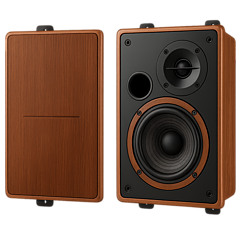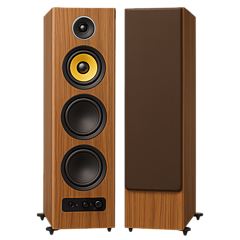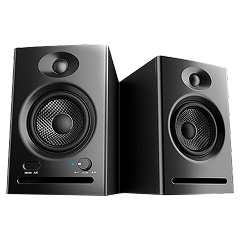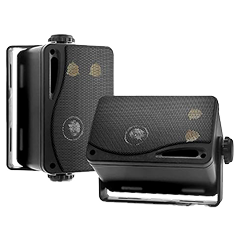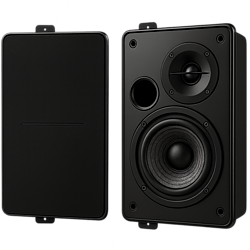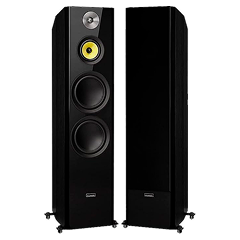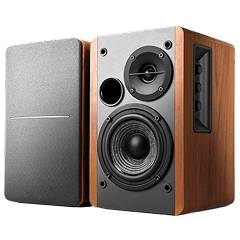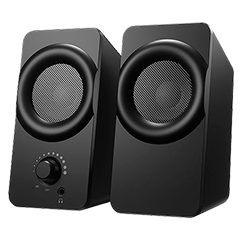Les enceintes colonnes ont quelque chose d’impressionnant visuellement, n’est-ce pas ? À condition qu’elles aient été soigneusement conçues et finies, elles peuvent être considérées autant comme des « meubles » que comme des « enceintes ».
Ce guide vous expliquera ce que sont les enceintes colonnes, les caractéristiques techniques importantes et comment les adapter à votre espace et à votre système son, afin que vous puissiez obtenir le son désiré sans dépenser trop ni trop peu.
Que sont les enceintes colonnes passives ?
Des enceintes colonnes passives sur pied sont des enceintes hautes et autonomes conçues pour être posées directement sur le sol (contrairement aux enceintes bibliothèque, qui sont posées sur des supports ou des étagères). Le fait qu’elles soient « passives » signifie qu’elles nécessitent un amplificateur externe ou un récepteur AV pour les alimenter.
Par rapport aux modèles plus petits destinés aux étagères, les enceintes colonnes présentent généralement les caractéristiques suivantes :
- Des enceintes plus grandes pouvant accueillir des haut-parleurs plus volumineux ou plus nombreux.
- Offrent des basses plus profondes et une scène sonore plus riche.
- Remplissent plus facilement les grandes pièces sans distorsion à volume élevé.
La différence la plus évidente est bien sûr d’ordre physique. Une enceinte colonne est naturellement conçue pour être posée au sol plutôt que placée sur une étagère ou soutenue par un pied.
Une enceinte plus grande permet d’utiliser des haut-parleurs plus grands, et parfois plus nombreux. Si vous avez lu notre guide principal pour l’achat d’enceintes, vous savez que « des haut-parleurs plus grands = un plus grand mouvement d’air », ce qui signifie « une plus grande ampleur » et « des basses plus profondes ». Si vous recherchez un son puissant avec une véritable extension des basses et que vous disposez d’une pièce suffisamment grande pour permettre à ces enceintes plus volumineuses de fonctionner librement, une enceinte colonne pourrait bien vous convenir.
Le facteur prix
Même si vous n’avez pas besoin de prévoir un budget pour les supports, la différence de prix entre les enceintes de bibliothèque et leurs homologues sur pied peut sembler disproportionnée. Mais il y a de bonnes raisons à cela.
La fabrication d’une enceinte d’un mètre de haut ou plus nécessite davantage de matériaux. Le volume interne plus important doit être soigneusement conçu pour éviter les ondes sonores perturbatrices à l’intérieur de l’enceinte. Si elles ne sont pas contrôlées, ces ondes peuvent nuire aux performances du haut-parleur et provoquer une résonance de l’enceinte elle-même. Pour éviter cela, les fabricants utilisent des renforts et des amortisseurs internes, ce qui augmente le coût.
À cela s’ajoute le coût supplémentaire lié à l’utilisation de haut-parleurs plus grands et plus nombreux.
Les enceintes colonnes d’entrée de gamme coûtent entre 400 et 600 euros la paire, tandis que les modèles de milieu de gamme coûtent entre 1 000 et 3 000 euros. Les modèles haut de gamme, dotés de renforts avancés et de haut-parleurs haut de gamme, peuvent facilement dépasser les 4 000 euros.
Adapter la taille des enceintes à la taille de la pièce
Les enceintes plus grandes, capables de déplacer beaucoup d’air et de créer une scène sonore à grande échelle, nécessitent un espace relativement important pour fonctionner. Sinon, les ondes sonores se répercutent trop rapidement sur les murs et créent un déséquilibre. Vous recherchez la précision, la concentration stéréo et une scène sonore convaincante. Cela n’est possible que si l’enceinte n’est pas trop grande pour la pièce.
Et n’oubliez pas : chaque enceinte fonctionne mieux lorsqu’elle bénéficie d’un espace libre. Évitez de placer les enceintes colonnes dans un coin ou trop près des murs, et tenez compte des ports bass-reflex lorsque vous planifiez leur positionnement.
- Pièces de moins de 20 m² → Envisagez des enceintes colonnes plus petites avec des caissons plus fins.
- Pièces de 21 à 40 m² → Les enceintes colonnes standard avec des woofers de 15 à 18 cm offrent généralement de bonnes performances.
- Pièces de plus de 40 m² → Les modèles plus grands avec plusieurs haut-parleurs (y compris des haut-parleurs dédiés aux basses fréquences) sont idéaux.
Pour obtenir une image optimale, laissez un espace d’au moins 30 à 60 cm entre l’appareil et les murs arrière et latéraux.
Attentes en matière de réponse en fréquence
En matière de sensibilité, d’impédance et de distorsion, les enceintes colonnes obéissent aux mêmes règles que les enceintes bibliothèques. Elles se distinguent toutefois par leur réponse en fréquence.
Tout haut-parleur devrait atteindre la barre des 20 kHz dans le haut de la gamme de fréquences, car il s’agit de la limite de l’audition humaine. Mais seuls les grands haut-parleurs peuvent générer les ondes sonores à basse fréquence nécessaires pour descendre en dessous de 50 Hz.
Seules les enceintes colonnes les plus grandes et les plus chères sont capables de restituer des basses jusqu’à 20 Hz. Néanmoins, une conception performante devrait s’étendre au moins jusqu’à 40 Hz pour produire des basses profondes et satisfaisantes.
- Aigus : tous les modèles atteignent généralement 20 kHz.
- Graves : recherchez des modèles atteignant au moins 40 Hz (-3 dB). Les modèles haut de gamme peuvent descendre jusqu’à 25-30 Hz.
- Sensibilité : 88-90 dB est la norme ; tout ce qui dépasse 90 dB sera plus facile à gérer.
- Impédance : 8 ohms est la norme ; les modèles 4 ohms peuvent nécessiter un amplificateur plus puissant.
Connexion à l’amplificateur
Comme les enceintes colonnes ont souvent plusieurs haut-parleurs et une impédance plus faible, elles peuvent être plus exigeantes pour un ampli que les enceintes de bibliothèque. Il est super important de bien adapter la puissance de votre ampli aux besoins de vos enceintes pour éviter la distorsion et tirer le meilleur parti des haut-parleurs. Pour la plupart des enceintes colonnes de taille moyenne, choisissez un ampli qui délivre au moins 75 à 150 watts par canal sous 8 ohms. Si vos enceintes descendent à 4 ohms, assurez-vous que votre ampli soit stable à 4 ohms et qu’il puisse fournir une puissance correcte sans forcer.
Options de bi-câblage et de bi-amplification
De nombreuses enceintes colonnes sont équipées de doubles bornes de connexion, qui permettent le bi-câblage (séparation des signaux graves et aigus) ou la bi-amplification (utilisation de deux amplificateurs pour des gammes de fréquences distinctes). Bien que ces fonctionnalités ne soient pas indispensables, elles offrent davantage de flexibilité et, dans certains cas, améliorent les performances.
Même si vous ne prévoyez pas d’utiliser le bi-câblage ou la bi-amplification pour le moment, le fait de disposer de cette option rend votre achat plus « évolutif ».
Construction et matériaux des enceintes
La taille des enceintes colonnes rend la qualité de fabrication du caisson particulièrement importante. Les caissons mal construits peuvent résonner, provoquant une coloration indésirable. Recherchez des renforts solides, du MDF épais ou du bois composite, ainsi que des matériaux amortisseurs à l’intérieur du caisson.
Les modèles haut de gamme utilisent souvent du MDF d’au moins 18 à 25 mm d’épaisseur, avec des renforts internes pour réduire les vibrations des panneaux. Certaines enceintes haut de gamme utilisent des matériaux stratifiés ou composites pour plus de rigidité.
Esthétique et finitions
Les enceintes colonnes étant plus volumineuses et plus visibles dans une pièce, leur design et leur finition ont plus d’importance que pour les petites enceintes bibliothèque. Optez pour des finitions en placage, laquées ou peintes qui s’harmonisent avec votre intérieur, surtout si vos enceintes sont bien en vue.
Les finitions en bois foncé et noir mat sont classiques, tandis que les finitions brillantes ou les placages exotiques sont plutôt réservés aux modèles haut de gamme.
Intégration avec des caissons de basses
Bien que les enceintes colonnes offrent des basses plus profondes que les enceintes de bibliothèque, certains utilisateurs choisissent tout de même d’ajouter un caisson de basses pour leur home cinéma ou pour les très grandes pièces. L’intégration est plus harmonieuse avec des enceintes offrant des basses précises et contrôlées.
Si vos enceintes colonnes atteignent déjà 35 à 40 Hz sans distorsion, un caisson de basses n’est peut-être pas nécessaire pour écouter de la musique. Pour le home cinéma, l’idéal est d’associer des enceintes colonnes à un caisson de basses descendant jusqu’à 20 Hz.
Autres éléments à écouter
Une bonne extension des basses fréquences est importante dans une enceinte colonne, mais le contrôle de ces basses fréquences est tout aussi crucial. Sans un contrôle adéquat, les basses peuvent devenir imprécises et floues, rendant les rythmes lents.
La différence entre une enceinte capable d’exprimer avec précision le « début » et la « fin » des notes graves et une autre qui en est incapable est énorme. Des basses contrôlées rendent la musique naturelle et captivante, et empêchent les enregistrements complexes de paraître confus.
Au-delà des basses, écoutez :
- La restitution des détails – Les instruments d’accompagnement subtils sont-ils clairs ?
- La plage dynamique – Le haut-parleur peut-il passer de manière convaincante des passages doux aux crescendos puissants ?
- La largeur et profondeur de la scène sonore – La musique semble-t-elle remplir la pièce plutôt que de rester plate entre les haut-parleurs ?


